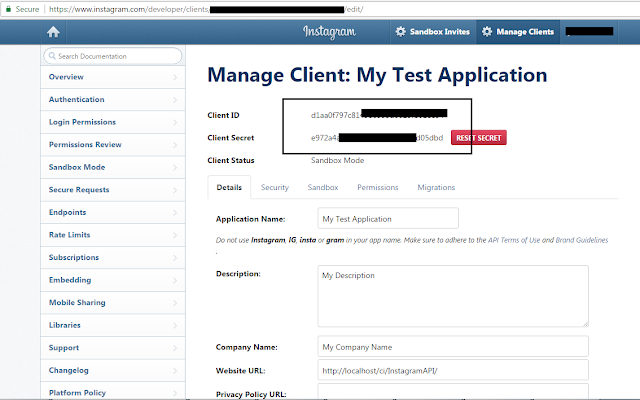You can develop a web-app to show Instagram images/photos from other users accounts using API call. Instagram API is the easiest so far to me. At first you have to visit https://www.instagram.com/developer/ to create a developer account and then an application for API communication as below steps:
The most important link is https://www.instagram.com/developer which describes API procedures.
You can create a Application and then you have client id and client secret as below screenshot.
Below is the full PHP code snippet to get images/photos from Instagram using API call:
<?php
session_start();
include_once "CurlExecutor.php";
define("CLIENT_ID", "d1aa0f7.............................");
define("CLIENT_SECRET", "e972a4a.........................");
define("REDIRECT_URI", "http://localhost/ci/InstagramAPI/");
if (isset($_SESSION["access_token"])) {
getRecentPhotos();
}
elseif (isset($_GET["code"])) {
getAccessToken();
}
else {
authentication();
}
function getRecentPhotos() {
$user_id = $_SESSION["user_id"];
$url = "https://api.instagram.com/v1/users/$user_id/media/recent/";
$url = $url . "?access_token=" . $_SESSION["access_token"];
$url = $url . "&count=5";
$response = CurlExecutor::execute($url);
$response["response"] = json_decode($response["response"]);
if ($response["code"] != 200) {
die("ERROR");
}
foreach ($response["response"]->data as $o) {
echo "<a target='_blank' href='" . $o->link . "'>";
echo "<img src='" . $o->images->low_resolution->url . "'/>";
echo "</a>";
}
}
function getAccessToken() {
$post = array(
"client_id" => CLIENT_ID,
"client_secret" => CLIENT_SECRET,
"grant_type" => "authorization_code",
"redirect_uri" => REDIRECT_URI,
"code" => $_GET["code"]
);
$response = CurlExecutor::execute("https://api.instagram.com/oauth/access_token", "POST", $post);
$response["response"] = json_decode($response["response"]);
CurlExecutor::prettyPrint($response);
if ($response["code"] != 200) {
die("ERROR");
}
$_SESSION["access_token"] = $response["response"]->access_token;
$_SESSION["user_id"] = $response["response"]->user->id;
header("Refresh:0; url=" . REDIRECT_URI);
}
function authentication() {
$auth_url = "https://api.instagram.com/oauth/authorize/?" .
"client_id=" . CLIENT_ID .
"&redirect_uri=" . REDIRECT_URI .
"&response_type=code";
header("Refresh:0; url=$auth_url");
exit();
}
?>
Authorization screen is as below screenshots (User will authorize this application and then forwarded to redirect URI with a one time code, you can use that code to get access token, and then you can get users photos as well as users basic info using those access token):
And output is as below:







